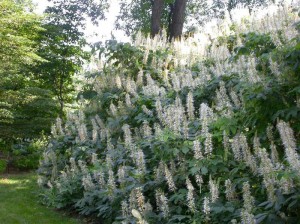Hello fellow readers; a beautiful assortment of plants can serve as transition shrubs from the lawn to woodland that can help hide unsightly views.
Weeds are misplaced plants.
Diane of Knowlton asked for tips to “tame her jungle,” which sounds like weeds could be her dilemma. Weeds are misplaced plants – not “a Mary original” definition but frequently used to justify my naturalized landscape, which seems much better than a weedy landscape. My motto is to keep the volunteers you like and remove the ones you don’t. However, there is the issue of invasive species, which is an exception to the rule.
Shrubs can provide a pleasing buffer from lawn to woods.
We live in a beautiful part of the country, so rather than meddling with Mother Nature, I suggest creating a transition from your lawn to natural areas such as bogs, fields, or woodlands. Planting transition shrubs between your lawn and native areas provides a pleasing buffer and can hide “uglies” such as downed trees and unsightly neighbor yard art or brush piles.
One of my favorite transition shrubs is Aesculus parviflora /Bottlebrush Buckeye reaching 8-12′ in height, and spread is excellent for massing, providing a wave of texture across the landscape. Full shade to full sun, although best with some shade hence ideal as a woodland buffer, this flexible fellow tolerates flooding and moderate drought and is deer resistant to boot. It flowers in June through July with showy white flowers that look like bottle brushes, hence its common name. Their flowers give way to glossy inedible, pear-shaped nuts (buckeyes) encased in husks.
Sambucus nigra ‘Eva,’ or other purple leaf varieties of Elderberry, is another favorite with musky-smelling flowers followed by reddish-black fall berries attractive to birds. Their fruits are yummy in jams, jellies, and pie fillings, though not as flavorful as the American elderberry /Sambucus canadensis.
Then there is Clethra alnifolia, commonly called Summersweet, a native deciduous shrub that flowers for about 4-6 weeks in July and August, and butterflies and bees adore them. Why not have a heavenly-smelling garden while taming your jungle?
Garden Dilemmas? AskMaryStone@gmail.com (and now on your favorite Podcast App.)
Updated July 25, 2020




